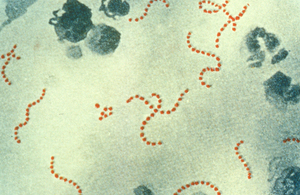Scarlet fever levels show a decline across England
PHE publishes latest figures for scarlet fever notifications.

Public Health England (PHE) has reported a decline in levels of scarlet fever across the country with 415 new cases reported last week (5 to 11 May 2014). While the weekly number of cases has reduced by half compared to mid-April, levels remain substantially elevated across the country. The total number of cases notified so far for 2014 is 8,322. This is the highest number of cases reported in a calendar year since 1980 when 11,118 notifications were made.
Scarlet fever is a seasonal disease and this is the time of year when we would expect to see a decline in the number of cases. While data from recent weeks does suggest that the decline has started, the fluctuation indicates a continued need to remain vigilant.
PHE are working closely with healthcare professionals to assess the impact of this season’s high levels of scarlet fever. Isolates have been submitted from laboratories across the country and analyses are underway to identify possible reasons for the widespread upsurge.
Dr Theresa Lamagni, PHE’s head of streptococcal infection surveillance, said:
It is still too early to be confident that the drop in the number of cases will be maintained as we are seeing fluctuating numbers each week and incidence remains high compared to recent years. We will continue to monitor the situation closely to see if there is a sustained fall over the coming months.
We strongly urge people to remain vigilant and to go to their GP if they develop symptoms which suggest scarlet fever such as a sore throat, fever and rash.
While scarlet fever is usually a mild illness it should be treated with antibiotics to reduce the risk of further complications. It is mainly a childhood disease, most common between the ages of 2 and 8 years, although adults can also develop scarlet fever.
Latest information on scarlet fever will continue being reported in the health protection report with statements issued when new information emerges.
Notes to editors
-
An average of 2,114 cases of scarlet fever, have been reported for the same period (September to April) in the previous 10 years (range 1,109 to 3,699).
-
Regional breakdowns for scarlet fever seasonal activity between September to April, England.
| PHE Centre Name | Number of cases in 2013 to 2014 season (weeks 37 in 2013 to weeks 19 in 2014) |
|---|---|
| Anglia and Essex | 407 |
| Avon, Gloucestershire and Wiltshire | 715 |
| Cheshire and Merseyside | 440 |
| Cumbria and Lancashire | 401 |
| Devon, Cornwall and Somerset | 294 |
| East Midlands | 1467 |
| Greater Manchester | 437 |
| Kent, Surrey and Sussex | 609 |
| London | 848 |
| North East | 592 |
| South Midlands and Hertfordshire | 463 |
| Thames Valley | 488 |
| Wessex | 416 |
| West Midlands | 800 |
| Yorkshire and the Humber | 887 |
| England | 9264 |
-
Read the latest health protection report.
-
Read the ‘Public health management of scarlet fever outbreaks in schools, nurseries and other childcare settings’ guidance.
-
There is currently no vaccine for scarlet fever.
-
More information on hand hygiene is available from the e-bug website.
-
Patient information is available from NHS Choices and PHE’s Frequently Asked Questions.
-
Further information on scarlet fever for health professionals.
-
Public Health England’s mission is to protect and improve the nation’s health and to address inequalities through working with national and local government, the NHS, industry and the voluntary and community sector. PHE is an operationally autonomous executive agency of the Department of Health. www.gov.uk/phe Follow us on Twitter @PHE_uk
UKHSA press office: National Infection Service
UKHSA press office, infectious diseases
61 Colindale Avenue
London
NW9 5EQ